Themed collection Editor’s Choice: Perovskite-based solar cells

The impact of ligands on the synthesis and application of metal halide perovskite nanocrystals
The surface ligation of metal halide perovskite nanocrystals (NC) influences the size/dimensionality, optoelectronic properties, chemical stability, and use of the NCs.

J. Mater. Chem. A, 2021,9, 23419-23443
https://doi.org/10.1039/D1TA05242J
The crucial roles of the configurations and electronic properties of organic hole-transporting molecules to the photovoltaic performance of perovskite solar cells
The relationship among molecular structure, molecular packing, and performance of HTMs in perovskite solar cells is systematically discussed from molecular configurations and electron properties, aiming to guide the design of efficient HTMs.
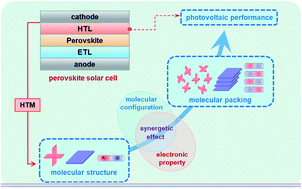
J. Mater. Chem. A, 2021,9, 18148-18163
https://doi.org/10.1039/D1TA03718H
Earth-abundant non-toxic perovskite nanocrystals for solution processed solar cells
In this review, we summarize non-toxic perovskite nanocrystals incorporated in solar cells. We also discuss factors limiting efficiency, the approaches followed to overcome these limitations, and possible solutions to improve efficiency.
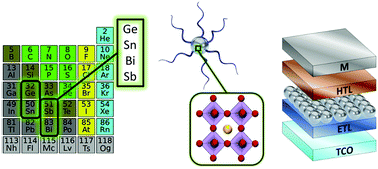
Mater. Adv., 2021,2, 4140-4151
https://doi.org/10.1039/D1MA00245G
Insights into iodoplumbate complex evolution of precursor solutions for perovskite solar cells: from aging to degradation
The evolution of the characteristics of a perovskite precursor solution driven by its components, the aging effect, degradation effect, and humidity effect and their impact on the physical properties of perovskite films (and perovskite solar cell performance) is summarized.
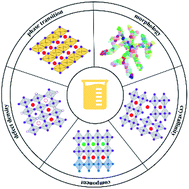
J. Mater. Chem. A, 2021,9, 6732-6748
https://doi.org/10.1039/D0TA12094D
Oxygen-induced defect-healing and photo-brightening of halide perovskite semiconductors: science and application
The advancement of physical/chemical insights into oxygen induced defect passivation and the associated photo-brightening in the emerging metal halide perovskite semiconductors towards various optoelectronic applications is summarized.
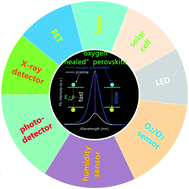
J. Mater. Chem. A, 2021,9, 4379-4414
https://doi.org/10.1039/D0TA10946K
Gas flow-assisted vacuum drying: identification of a novel process for attaining high-quality perovskite films
Controlling the nucleation and crystal growth in solution-processed metal halide perovskite (MHP) thin films is the pivotal point in fabricating homogenous and pinhole-free films.

Mater. Adv., 2021,2, 5365-5370
https://doi.org/10.1039/D1MA00494H
Merged interface construction toward ultra-low Voc loss in inverted two-dimensional Dion–Jacobson perovskite solar cells with efficiency over 18%
By introducing a pretreatment combined with a merged annealing method, a dual-function PC61BM, which passivates interface defects and improves charge transport, was achieved to boost the PCE of 2D Dion–Jacobson perovskite solar cells to over 18%.
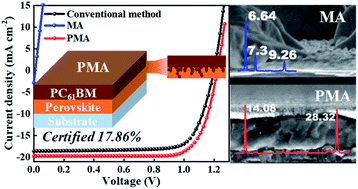
J. Mater. Chem. A, 2021,9, 12566-12573
https://doi.org/10.1039/D1TA02015C
Influence of the stoichiometry of tin-based 2D/3D perovskite active layers on solar cell performance
The starting stoichiometry of 2D/3D (PEA0.08FAxSnI3) tin perovskite films influences their crystallization and photophysical properties as well as the solar cell performance.

J. Mater. Chem. A, 2021,9, 10095-10103
https://doi.org/10.1039/D0TA10277F
Optimization of SnO2 electron transport layer for efficient planar perovskite solar cells with very low hysteresis
In this work, we introduce a bilayer ETL composed of lithium (Li)-doped compact SnO2 (c-SnO2) and potassium-capped SnO2 nanoparticle layers (NP-SnO2) to enhance the electron extraction and charge transport properties in perovskite solar cells, resulting in an improved PCE and a strongly reduced J–V hysteresis.

Mater. Adv., 2022,3, 456-466
https://doi.org/10.1039/D1MA00585E
Thermodynamic stability screening of IR-photonic processed multication halide perovskite thin films
Two hundred sixty-six films processed with flash infrared annealing were optically and structurally characterized. We determine the optimum conditions for the formation of the mixed-cations halide perovskite active phase.

J. Mater. Chem. A, 2021,9, 26885-26895
https://doi.org/10.1039/D1TA05248A
Triple-cation perovskite solar cells fabricated by a hybrid PVD/blade coating process using green solvents
A novel and scalable PVD/blade coating method of the perovskite absorber is presented. In conjunction with charge transporting layers blade coated in ambient air using non-toxic solvents, these perovskite solar cells achieved 18.7% efficiency.

J. Mater. Chem. A, 2021,9, 26680-26687
https://doi.org/10.1039/D1TA07579A
Sensitivity of mixed cation/halide perovskites to evaporation kinetics of DMSO at an early stage
The control of evaporation kinetics depends on perovskite compositions.
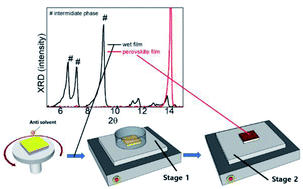
J. Mater. Chem. A, 2021,9, 26248-26255
https://doi.org/10.1039/D1TA08462C
Surface recrystallized stable 2D–3D graded perovskite solar cells for efficiency beyond 21%
An ambient stable surface recrystallized 2D–3D graded perovskite solar cell reveals excellent efficiencies of 21.18% (0.12 cm2) and 18.81% (2 cm2).
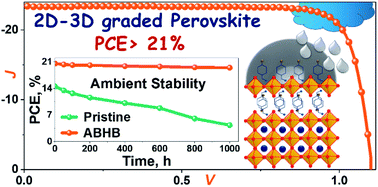
J. Mater. Chem. A, 2021,9, 26069-26076
https://doi.org/10.1039/D1TA06901B
High throughput screening of novel tribromide perovskite materials for high-photovoltage solar cells
A highly efficient composition screening protocol based on high throughput inkjet printing of perovskite films is developed to accelerate the discovery of novel tribromide perovskites for high-photovoltage solar cells.

J. Mater. Chem. A, 2021,9, 25502-25512
https://doi.org/10.1039/D1TA06594G
An organometal halide perovskite photocathode integrated with a MoS2 catalyst for efficient and stable photoelectrochemical water splitting
An organometal halide perovskite (OHP) photocathode integrated with a MoS2 catalyst achieved long-term photoelectrochemical (PEC) stability and high half-cell solar-to-hydrogen conversion efficiency (HC-STH).
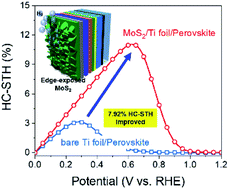
J. Mater. Chem. A, 2021,9, 22291-22300
https://doi.org/10.1039/D1TA05377A
Evolution of ferroelectric domains in methylammonium lead iodide and correlation with the performance of perovskite solar cells
The microscopic analysis of MAPbI3 elucidates the evolution of ferroelectric polarization and its impact on the performance of perovskite solar cells.
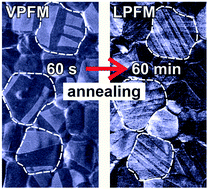
J. Mater. Chem. A, 2021,9, 21845-21858
https://doi.org/10.1039/D1TA06290E
Improved stability and efficiency of perovskite/organic tandem solar cells with an all-inorganic perovskite layer
This work presents high-performance and stable all-inorganic perovskite/organic tandem solar cells with a champion efficiency of 18.06% and excellent stability under light and thermal conditions.
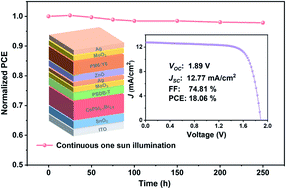
J. Mater. Chem. A, 2021,9, 19778-19787
https://doi.org/10.1039/D0TA12286F
Balancing crystallization rate in a mixed Sn–Pb perovskite film for efficient and stable perovskite solar cells of more than 20% efficiency
A surface treatment of PEDOT:PSS layer with [PNA]BF4 is employed to realize vertically homogeneous distribution of Sn/Pb-containing perovskite films through balancing its crystallization rate and achieving chemical encapsulation of the acidic PEDOT:PSS substrate.

J. Mater. Chem. A, 2021,9, 17830-17840
https://doi.org/10.1039/D1TA04922D
Two-step MAPbI3 deposition by low-vacuum proximity-space-effusion for high-efficiency inverted semitransparent perovskite solar cells
The innovative two-step Low Vacuum-Proximity Space Effusion (LV-PSE) method exploits the conversion of a textured PbI2 layer into MAPbI3 by adsorption–incorporation–migration of energetic MAI molecules, thus enabling a best efficiency of 17.5% in 150 nm thick layers.

J. Mater. Chem. A, 2021,9, 16456-16469
https://doi.org/10.1039/D1TA02535J
An over 20% solar-to-hydrogen efficiency system comprising a self-reconstructed NiCoFe-based hydroxide nanosheet electrocatalyst and monolithic perovskite/silicon tandem solar cell
A monolithic perovskite/silicon tandem solar cell was used for highly efficient standalone solar water splitting.
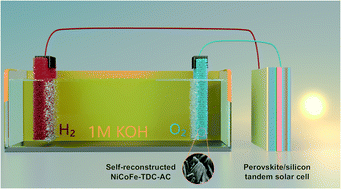
J. Mater. Chem. A, 2021,9, 14085-14092
https://doi.org/10.1039/D1TA03126K
The efficacy of Lewis affinity scale metrics to represent solvent interactions with reagent salts in all-inorganic metal halide perovskite solutions
The Gutmann donor number (DN) and the lithium cation affinity (LCA) describe solvent-Lewis acid interactions in all-inorganic metal halide perovskite solutions.
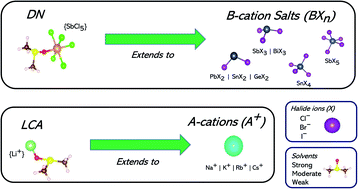
J. Mater. Chem. A, 2021,9, 13087-13099
https://doi.org/10.1039/D1TA03063A
A high-throughput study of oxynitride, oxyfluoride and nitrofluoride perovskites
Perovskite solar devices are nowadays the fastest advancing photovoltaic technology.

J. Mater. Chem. A, 2021,9, 8501-8513
https://doi.org/10.1039/D0TA10781F
An in situ bifacial passivation strategy for flexible perovskite solar module with mechanical robustness by roll-to-roll fabrication
An in situ bifacial passivation strategy is developed to improve the performance of flexible perovskite solar module during roll-to-roll printing.

J. Mater. Chem. A, 2021,9, 5759-5768
https://doi.org/10.1039/D0TA12067G
Performance improvement of MXene-based perovskite solar cells upon property transition from metallic to semiconductive by oxidation of Ti3C2Tx in air
Oxidization of Ti3C2Tx hydrocolloid is carried out to tune its properties desirable for an electron transport layer in low-temperature processed perovskite solar cells, rendering a champion power conversion efficiency of 18.29%.

J. Mater. Chem. A, 2021,9, 5016-5025
https://doi.org/10.1039/D0TA11397B
Entropy-driven stabilization of the cubic phase of MaPbI3 at room temperature
Methylammonium lead iodide (MAPbI3) is an important light-harvesting semiconducting material for solar-cell devices.
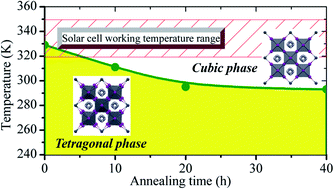
J. Mater. Chem. A, 2021,9, 1089-1099
https://doi.org/10.1039/D0TA10492B
About this collection
The newly appointed Journal of Materials Chemistry A and Materials Advances Advisory Board member, Zhiqun Lin (Georgia Institute of Technology, USA), who has recently come to the end of his time as an Associate Editor, has gathered together the journals’ most outstanding recent papers in perovskite-based photovoltaics for this Editor’s Choice collection.
This Editor’s Choice collection highlights recent advances in perovskite solar cells (PSCs) research in 2021. Four research areas are clearly evident: (i) increasing the efficiency and stability of PSCs; (ii) in conjunction with experimental investigation, more frequent implementation of theoretical approaches, including DFT calculation and machine learning, to elucidate the underlying mechanism and/or perform systematic study; (iii) much effort on large-scale PSCs or small solar modules, particularly flexible perovskite solar modules by roll-to-roll fabrication; and (iv) expanding research from single junction solar cells to tandem solar cells and hybrid devices.
To highlight developments in perovskite-based photovoltaics, this online collection summarizes recent experimental papers and reviews published on the topic. We hope you enjoy reading this collection.